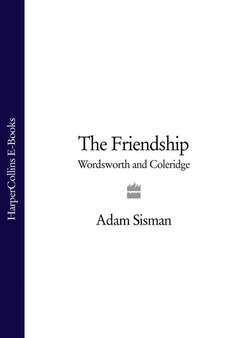Читать книгу The Friendship: Wordsworth and Coleridge - Adam Sisman - Страница 7
INTRODUCTION
ОглавлениеOne June afternoon, more than two hundred years ago, a young man halted by a field-gate overlooking an isolated Dorset valley. His name was Samuel Taylor Coleridge, and he was twenty-four years old. He had walked forty miles since leaving his cottage in the Quantock Hills early the previous morning.
Beyond the gate, a cornfield stretched downhill towards the side of a substantial house, built in brick and partly covered by grey stucco render. In the kitchen garden two figures, a man and a woman, both about his own age, could be seen working; first one, then the other, paused and looked up towards where he stood.
The lane continued in a wide arc to the front of the house. Too impatient to take this long way round, Coleridge vaulted over the gate and bounded across the field towards the waiting figures, leaping through the corn. The two watchers, William Wordsworth and his sister Dorothy, retained a distinct memory of this sight almost half a century afterwards.1
Until this moment, Wordsworth and Coleridge had met only a handful of times. Now Coleridge planned to stay several days with his new friend – but they soon found that this was not enough, and he repeatedly postponed his departure. The two had much to say to each other, and after more than three weeks neither wanted to part; so it was rapidly arranged that the Wordsworths would move to the Quantocks. There the poets lived in close proximity, meeting almost daily, composing and developing their work together. This was an intensely creative time for them both. Under the constant stimulus of the other, each man would write some of his finest poetry. Ideas, themes and images would pass back and forth between them, one poem prompting a response from the other in exhilarating succession. And though this miraculously fertile period lasted only sixteen months, it was the seed-time of fruit that would ripen through the subsequent decade. Two years later their association would be renewed in the Lakes, where there would be a brief reprise of their poetic duet.
If Coleridge’s arrival on that June afternoon in 1797 was not the beginning of their acquaintance, it was the beginning of their intimacy. Previously they had exchanged ideas, expressed mutual regard, and offered friendly criticism. Now the relationship became much closer, one of dialogue and collaboration, of sharing plans and dreams.
The names of Wordsworth and Coleridge have been linked ever since. They have passed into legend as a pair, like Boswell and Johnson, or Lennon and McCartney. The myth-making began while they were still living, and has continued uninterrupted. The image of these two young geniuses, the progenitors of English Romanticism, roaming the Quantock Hills in an ecstasy of shared understanding and creative fulfilment, is irresistibly romantic. Their subsequent estrangement, quarrel, and superficial reconciliation complete a story as poignant as any love affair.
A shared ambition dominated the friendship between the two men. Both believed ardently that poetry could occupy a central place in the culture of the age. The visionary Coleridge dreamed of a great poem – perhaps greater than any yet written. It would encompass all human knowledge, and take twenty years to write. It would ensure the poet a place among the immortals; more important, it would hasten in the ‘blessed day’ of Mankind’s redemption, ‘the day fairer than this’: beginning where Milton left off.
Coleridge had scarcely sketched his utopian scheme before deciding that his friend was better suited to realise it. Wordsworth accepted the commission. For many years he struggled heroically to write this impossible poem, until at last he abandoned it, bitterly disappointed. The friendship that had been so productive at the beginning would end in failure.
‘Why do people have to like Wordsworth and hate Coleridge and vice versa?’ asked Edmund Blunden.2 The residual bitterness after their falling out has tended to distort subsequent interpretation of the relations between the poets. As a stimulating scholar who has written recently on relations between the two men has pointed out, understanding of them has been bedevilled by partisanship: ‘The practice of elevating one figure over the other has dominated Coleridge and Wordsworth biography for decades; to some extent because the very closeness of the two writers was later wrecked by savage disagreement. Interpreting one of them sympathetically almost inevitably means showing the other in a bad light.’3
My book is an attempt to escape from this biographical impasse, by concentrating on the friendship itself, at its most intense when both men were young and full of hope. Its core is the period of six and a half years between Coleridge’s exuberant arrival at Racedown Lodge and his sad departure for Malta. This is the story of two marvellously gifted young men, for whom anything seemed possible. At the outset, their friendship was beneficial to both, pushing each to higher aspirations. Overhanging all was their joint mission, to fulfil the hopes of a generation disappointed at the failure of the French Revolution: nothing less than a poem that would change the world.
